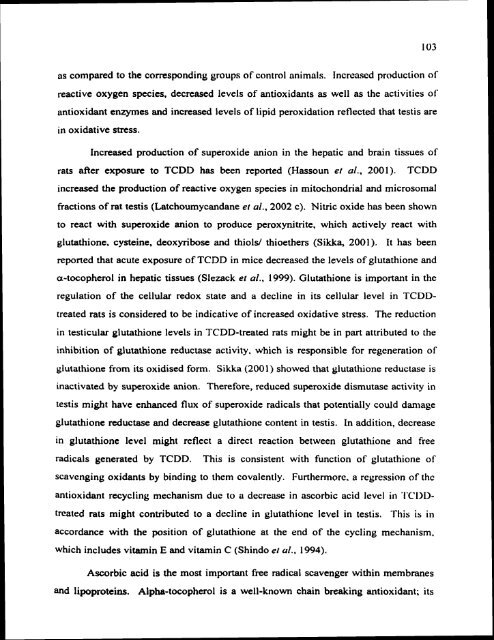ON TESTIS AND EPlDlDYMlS OF RATS - Pondicherry University ...
ON TESTIS AND EPlDlDYMlS OF RATS - Pondicherry University ...
ON TESTIS AND EPlDlDYMlS OF RATS - Pondicherry University ...
You also want an ePaper? Increase the reach of your titles
YUMPU automatically turns print PDFs into web optimized ePapers that Google loves.
as compared to the corresponding groups of control animals. Increased production of'<br />
reactive oxygen species. decreased levels of antioxidants as well as the activities of'<br />
antioxidant enzymes and increased levels of lipid peroxidation reflected that testis are<br />
In oxidative stress.<br />
Increased production of superoxide anion in the hepatic and brain tissues of<br />
rats after exposure to TCDD has been reponed (Hassoun r! ul., 2001). TCDD<br />
increased the production of reactive oxygen species in mitochondria1 and microsomal<br />
fractions of rat testis (Latchoumycandane er ul., 2002 c). Nitric oxide has been shown<br />
to react with superoxide anion to produce peroxynitrite, which actively react with<br />
glutathione, cysteine, deoxyribose and thiolsl thioethers (Sikka, 2001). It has been<br />
reported that acute exposure of TCDD in mice decreased the levels of glutathione and<br />
a-tocopherol in hepatic tissues (Slezack el a[.. 1999). Glutathione is important in the<br />
regulation of the cellular redox state and a decline in its cellular level in TCDDtreated<br />
rats is considered to be indicative of increased oxidative stress. The reduction<br />
in testicular glutathione levels in TCDD-treated rats might be in part attributed to the<br />
inhibition of glutathione reductase activity, which is responsible for regcneration of<br />
glutathione from its oxidised form Sikka (2001) showed that glutathione reductase is<br />
inactivated by superoxide anion. Therefore, reduced superoxide dismutase activity in<br />
testis might have enhanced flux of superoxide radicals that potentially could damage<br />
glutathione rcductase and decrease glutathione content in testis. In addition, decrease<br />
in glutathione level might reflect a direct reaction between glutathione and free<br />
radicals generated by TCDD. This is consistent with function of glutathione of<br />
scavenging oxidants by binding to them covalently. Furthermore. a regression of thc<br />
antioxidant recycling mechanism duc to a decrease in ascorbic acid level in 'l'CI)Vtreated<br />
rats might contributed to a decline in glutathione level in testis. This is in<br />
accordance with the position of glutathione at the end of the cycling mechanism.<br />
which includes vitamin E and vitamin C (Shindo er ul.. 1994).<br />
Ascorbic acid is the most important free radical scavenger within membranes<br />
and lipoproteins. Alpha-tocopherol is a well-known chain breaking antioxidant; its

















